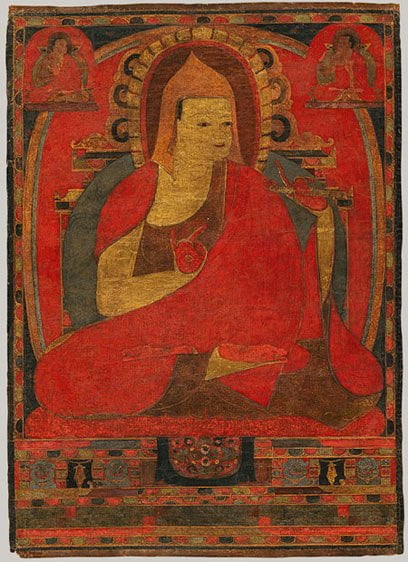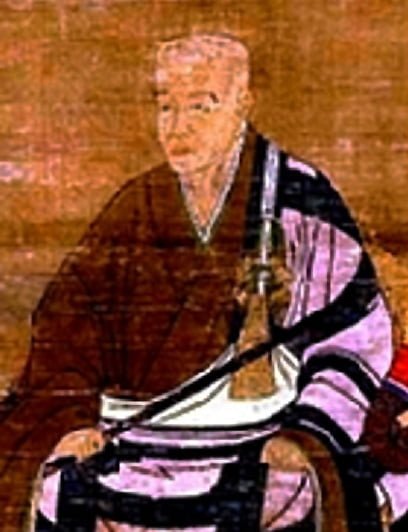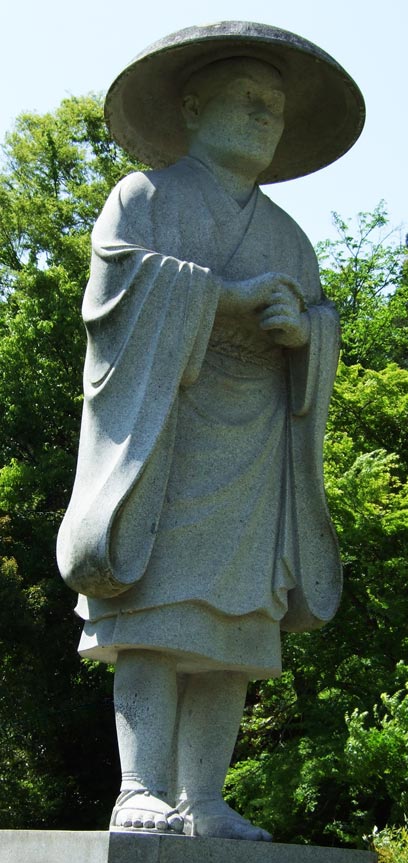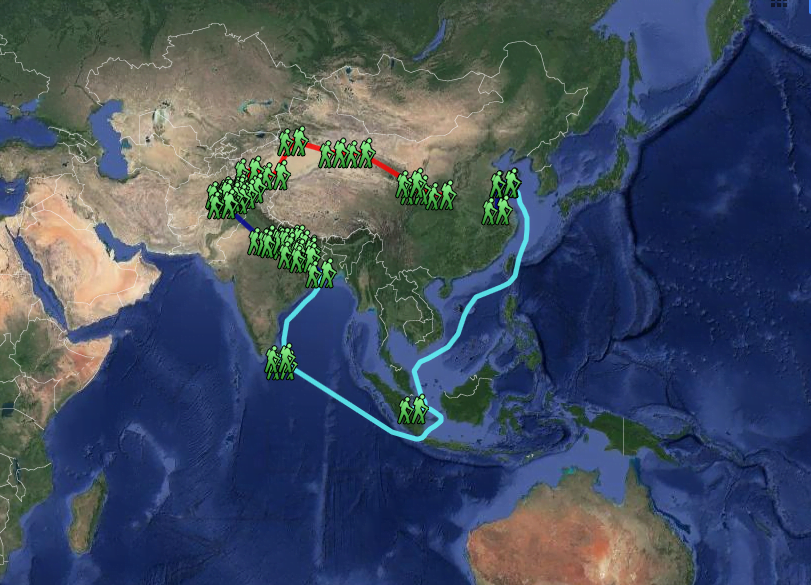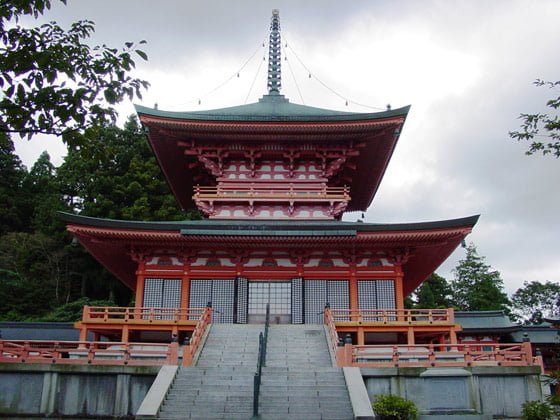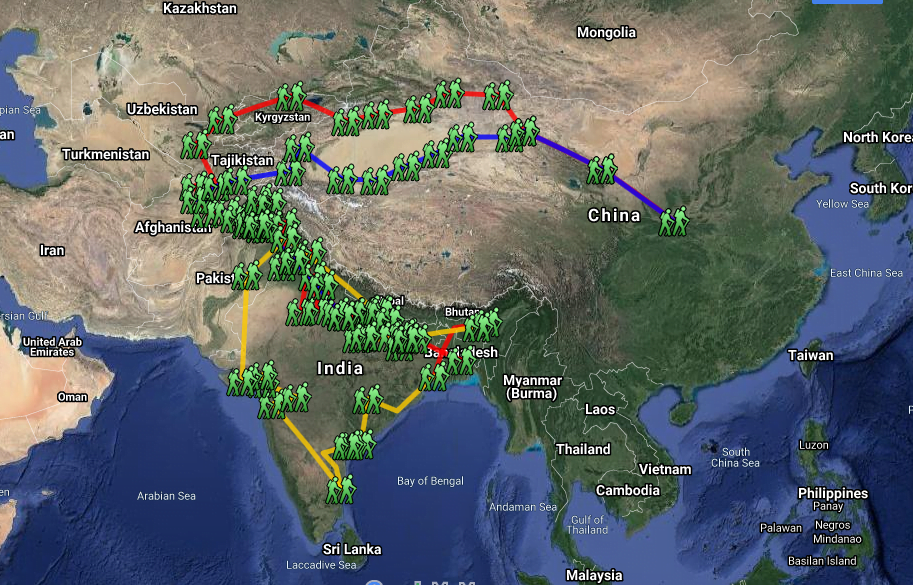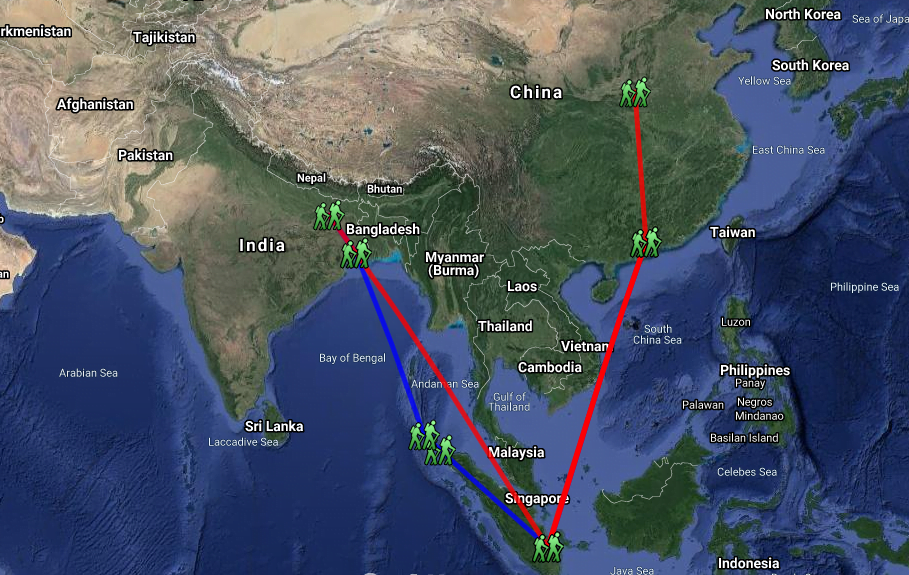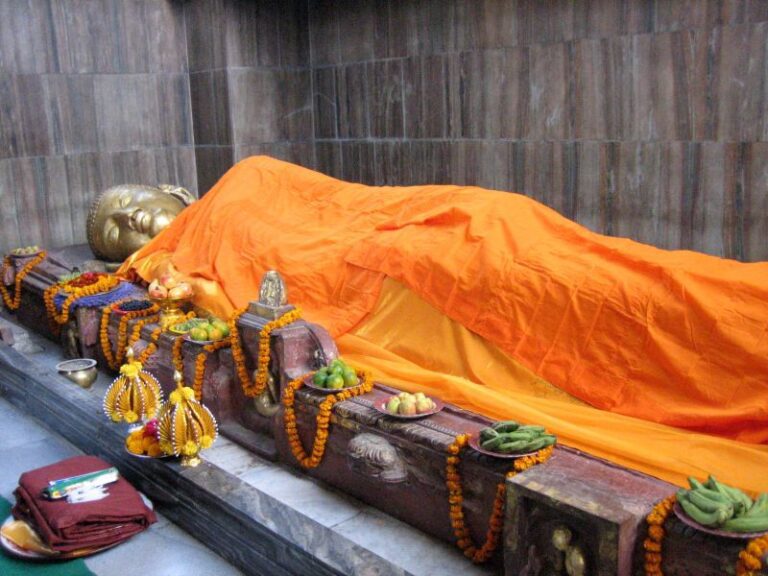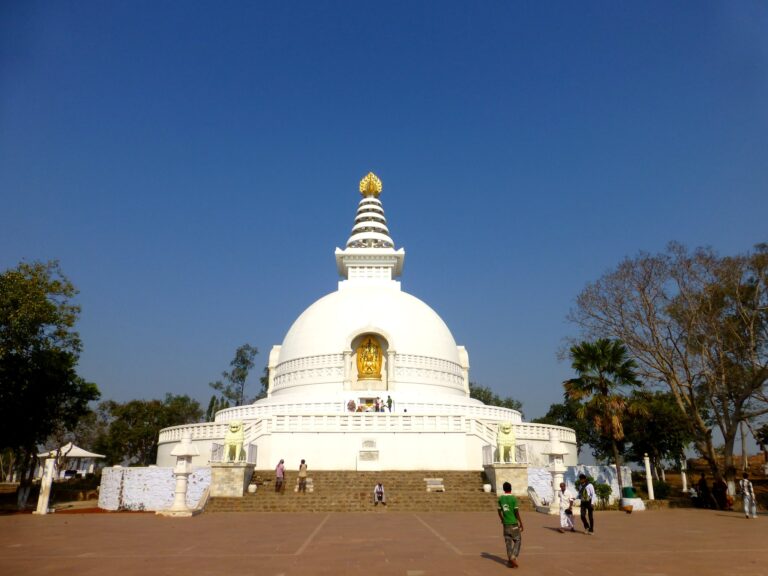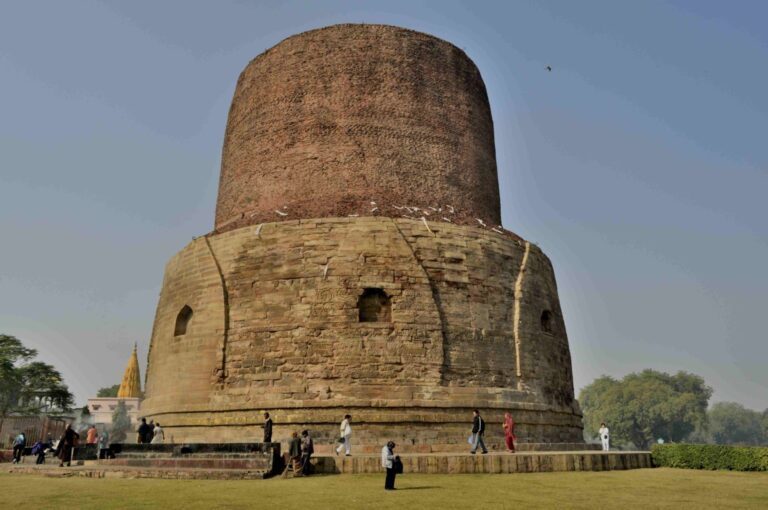A look of the best-known Buddhist Pilgrims from China, India and Japan: Atisha, Dogen, Eisai, Ennin, Faxian, Hye-ch’o, Kukai, Saicho, Xuanzang and Yijing.
Atisha (980-1054)
Atisha was one of the major figures in the second diffusion of Buddhism in the central regions of Tibet, after a chaotic period from the mid 9th century until the 11th century when the royal line and its patronage were destroyed.
Born into a wealthy family, Atisha studied at Nalanda and was ordained as a monk. He made a pilgrimage to Bodhgaya and then travelled for 13 months to Sumatra where he studied for 12 years under Dharmarakshita. He then returned to India and was given a position as abbot at the Buddhist monastery of Vikramasila in north east India.
He was invited to Tibet and after a two year journey arrived at Ngari in western Tibet in 1042, where he spent three years. Finally be travelled to Netang, near Lhasa where he remained until the end of his life nine years later. He wrote, translated and edited more than 200 books which helped spread the second diffusion of Buddhism in Tibet.
Portrait of Japanese monk, Dōgen
Dogen (1200-1253)
Dogen was founder in 1227 of the Soto sect of Zen Buddhism and of the monastery Eiheiji (now part of Fukui Prefecture). Born in Kyoto to a noble family, Dogen entered monastic life at Yokawa on Mt. Hiei in 1213, where he studied Tendai sect esotericism and received ordination. Around 1214 he was referred to Eisai, founder of the Rinzai sect of Zen Buddhism, and entered the temple Kenninji in about 1217 where he studied the Rinzai tradition.
In 1223 Dogen went to Mingzhou in what is now Zhejiang Province, China. After studying at the monastery Jingdesi on Mt. Tiantong, Dogen made a pilgrimage to various monasteries in Zhejiang. He learned that the Soto Zen master Zhangweng Rujing had become head of the monastery on Mt. Tiantong so he returned in 1225 and became his student. Within two months, Dogen made a breakthrough to enlightenment. Rujing recognized Dogen’s spiritual progress and in 1227 presented him with a certificate declaring him his successor in the tradition of Soto Zen.
Upon his return to Japan Dogen initially resided at Kenninji where his single-minded advocacy of Zen provoked the animosity of monks at the Tendai centres on Mt. Hiei and at Kenninji, and in 1230 he moved to An’yoin, a temple in Kyoto where he wrote his influential treatise ‘Discourse on the Practice of the Way’. In 1233 he moved to a nearby temple, Kannon Doriin, which was expanded in 1236 and renamed Kosho Horinji, becoming the first Soto Zen monastery in Japan.
Dogen wrote further treatises where he asserted that enlightenment is accessible to any person through reliance solely on meditation in the Lotus position. In 1243 Dogen moved his headquarters to Echizen Province, where he wrote more treatises and in 1244 he founded the temple Daibutsuji, later renamed Eiheiji, which rose to eminence as the centre of Soto Zen from the late 16th century. Eiheiji continues to be a major Zen institution known for its rigorous monastic discipline.
Portrait of Japanese monk, Eisai
Eisai (1141-1215)
Eisai began his study of Buddhist teachings when aged seven and at the age of 13 he took the preliminary Buddhist precepts at Enryakuji, a major Tendai sect temple near Kyoto, and became a monk there. Eisai became increasingly disillusioned with the laxity of monastic discipline in the Enryakuji community and in 1168 he set out on a pilgrimage to Song China.
During his five months there he visited Tendai monastic sites and gathered Tendai texts. In 1187 he made a second journey to China, studying Zen under the Rinzai master Xu’an Huaichang. Under Xu’an’s guidance Eisai combined meditation with the study of esoteric practices. Upon his return to Japan in 1191 (with Zen scriptures and the seeds of green tea) Eisai began to advocate the Chinese Zen teachings which aroused the anger of the Enryakuji monks and their supporters at the imperial court.
In 1199 he travelled to Kamakura to seek the patronage of the newly established military government – which he obtained. In 1202 he was made founder-abbot of a new monastery, Kenninji, where he taught a combination of Zen, Tendai, and esoteric Buddhism. Among his notable disciples was Eihei Dogen, who himself traveled to China and returned to found the Soto school of Zen in Japan.
Image of Japanese monk, Ennin
Ennin (about 794-864)
In 809 Ennin became a disciple at the temple Enryakuji on Mount Hiei of Saicho, the Buddhist priest credited with the founding of the Tendai school of Buddhism. After studying esoteric and Tendai Buddhism in China (838-847) Ennin returned to Mount Hiei to propagate esoteric doctrines, which within several years came to dominate the Tendai sect. He built storerooms to house the sutras and religious instruments he had brought back with him from China.
In 854 Ennin was appointed the third chief abbot of the Tendai sect and was later given the posthumous title Jikaku Daishi. He wrote more than 100 books and the diary of his travels in China (translated into English by Professor Edwin O Reischauer entitled ‘Ennin’s Diary: The Record of a Pilgrimage to China in Search of the Law’) provides an invaluable source of information about life in Tang China and Silla Korea.
Faxian’s Buddhist pilgrimage route
Faxian (about 337-422)
Born in Wuyang, Shanxi province, Faxian became a novice Buddhist monk at three years old. Following his ordination and a subsequent period of study in Chang’an, he embarked upon a pilgrimage to India in 399 AD. He travelled west to Dunhuang, then continued across the desert to reach Khotan where he stayed for three months. Over the next six years he visited Gandhara and many of the Buddhist sacred sites and monasteries in India.
Boarding a merchant ship, Faxian began the long voyage home, stopping in Sri Lanka for two years in order to search for important Buddhist texts which did not exist in China. Resuming his journey, the ship took him to Java and then finally to the coast of Shandong in 413. Settling in the city of Qingzhou, he set to work, translating the Buddhist texts he had collected. He related the story of his long pilgrimage to his friend, Buddha Bhadra, who later wrote down these reminiscences which formed the work known as ‘Record of the Buddhistic Kingdoms’. This work provides an important source of information on Buddhism and the Silk Road at the beginning of the 5th century.
Manjusri painted thangka
Hye-ch’o (about 704-787)
At 19 years old, with the encouragement of the Indian monk Vajrabodhi and his disciple Amogha who had been living in Kuang-chou in south China, Hye-ch’o made the sea journey to India, arriving at Tamralipti, close to modern Calcutta.
He travelled extensively in India, visiting not only the pilgrimage sites of Kusinagara, Bodhgaya and Rajagrha, but also the Chalukya kingdom in south India, the Valabhi kingdom in west India and Jalandhara in north India. Details of all his travels together with social commentaries were included in his diaries (‘Wang och’onch’ukguk chon’).
Travelling by land through Central Asia, Hye-ch’o returned to Chang’an where he assisted Vajrabodhi in the translation of an esoteric sutra devoted to Manjusri. Following Vajrabodhi’s death, he continued the work until Amogha’s death in 774.
Although he never returned to Silla, Hye-ch’o had great influence both as a Buddhist pilgrim and a favoured disciple of the most important teacher of the Tantric school in China.
Portrait of Japanese monk, Kukai
Kukai (774-835)
Kukai is better known by his posthumous title Kobo Daishi. Among his many achievements he is said to have created the simplified Japanese ‘kana’ syllabary, (a simplified form of the written Japanese language). He is also credited with bringing the tantric teachings of esoteric Buddhism from China and developing it into the uniquely Japanese Shingon sect, founding their headquarters on Mount Koya (Koyasan) near Osaka.
He was born at what is now Zentsuji, Kagawa Prefecture, in Shikoku, into a declining aristocratic family. At the age of 18 he studied to become a statesman but withdrew after a few years and pursued his Buddhist studies while wandering about the country as an itinerant hermit practicing meditation. In 804 he sailed to China as a student monk and in Chang’an he studied under Huiguo, the patriarch of esoteric Buddhism, and returned to Japan in 806 a master of esoteric Buddhist teachings.
In 819 Kukai initiated construction of a monastic centre on Mt. Koya for the practice of esoteric Buddhist meditation. Kukai is considered the father of Japanese culture and is remembered as a wandering saint who engaged in severe ascetic practices and as the originator of the pilgrimage circuit of 88 temples on Shikoku.
Enryaku-ji, Mount Hiei, near Kyoto
Saicho (767-822)
Saicho was the founder of the Tendai sect of Buddhism in Japan. He altered the character of Buddhist monasticism by replacing the traditional precepts for monks with the simpler Mahayana precepts.
Born in what is now Shiga Prefecture, he began instruction in Buddhism at the age of 12 and took the clerical name Saicho when he received initial ordination at Nara aged 14. After final ordination in 785, he built himself a thatched hut on Mount Hiei north-east of Kyoto, intending a life of meditation and prayer; this hermitage later became the Tendai headquarters monastery of Enryakuji.
Some time before 797, he began to study the texts of the Chinese Tiantai sect (Tendai in Japanese). In 802 he received permission to study under a Chinese Tiantai master and left for China in 804. After his return in 805, the Emperor Kammu gave official recognition to the Tendai sect, stipulating that it include the practices of esoteric Buddhism which were primarily focused on the Lotus Sutra. In 866 Saicho was honoured by the imperial court with the posthumous title of Dengyo Daishi (Great Teacher Who Transmits the Teachings).
Xuanzang’s Buddhist pilgrimage route
Xuanzang (602-664)
Xuanzang was a Chinese Buddhist monk who travelled to India to collect and translate Buddhist scriptures. In 629 he left Chang’an, the capital of the Tang dynasty. Since he did not have the emperor’s permission to leave, he avoided Dunhuang and travelled across the desert to Turfan. With the help of the local king, a Buddhist monk, he was able to stop at other Silk Road oasis states along the northern route. He then travelled through Tashkent, Samarkand, Bamyan and Peshawar before arriving in northern India.
He studied for two years at a Buddhist monastery in Taxila and then two more years at the monastic university of Nalanda, and spent many years visiting Buddhist sacred sites. In 645, he returned to China along the southern Silk Road. He started the translation of the Buddhist scriptures he had brought with him. His travel accounts give detailed descriptions of the sites he visited and information about the Buddhist schools active in India at his time. His travels inspired the Ming novel Xiyouji (Journey to the West).
Yijing’s Buddhist pilgrimage route
Yijing (635-713)
Yijing travelled to India between 673 and 687, where he studied for many years at the monastery of Nalanda. His biography is an important source of information about pilgrimage between China and India. He records that several Buddhist monks used to reach India travelling through Tibet before the late 7th century, when the road was eventually blocked due to the political instability of the region.
Like other monks travelling to India, Yijing is reported to have donated Chinese silk fabrics and canopies to Buddhist sacred sites in India to acquire merit for himself and for Chinese believers, including his patrons, who could not go to India. Silk was often used by monks as a form of payment for daily expenses and as offering to Buddhist communities. In return, they would collect religious text and sacred relics.
On his way back to China, Yijing stopped in the kingdom of Srivijaya where he stayed to translate original Sanskrit Buddhist scriptures to Chinese. Once all the translation works were completed, he finally returned to Luoyang where he was received by the Empress Wu. His total journey took 25 years and he brought back some 400 Buddhist translated texts. His travel diaries include details of his journey to Srivijaya and India together with descriptions of the people of India and their lifestyles.
